MGT302 Strategic Management: Alternative Approaches Analysis
VerifiedAdded on 2023/06/11
|14
|3557
|135
Report
AI Summary
This report analyzes three strategic management approaches: stakeholder, dynamic capabilities, and sustainable. The stakeholder approach focuses on satisfying stakeholder needs for long-term success, exemplified by Starbucks' customer feedback-driven strategies. The dynamic capabilities approach, illustrated by Apple's adaptability, emphasizes responding to external changes. The sustainable approach, using IKEA as an example, integrates sustainability into long-term plans. The report discusses the viability, benefits, implementation issues, and limitations of each approach, providing a comprehensive overview of alternative strategic management strategies. Desklib is a platform where students can find similar assignments.
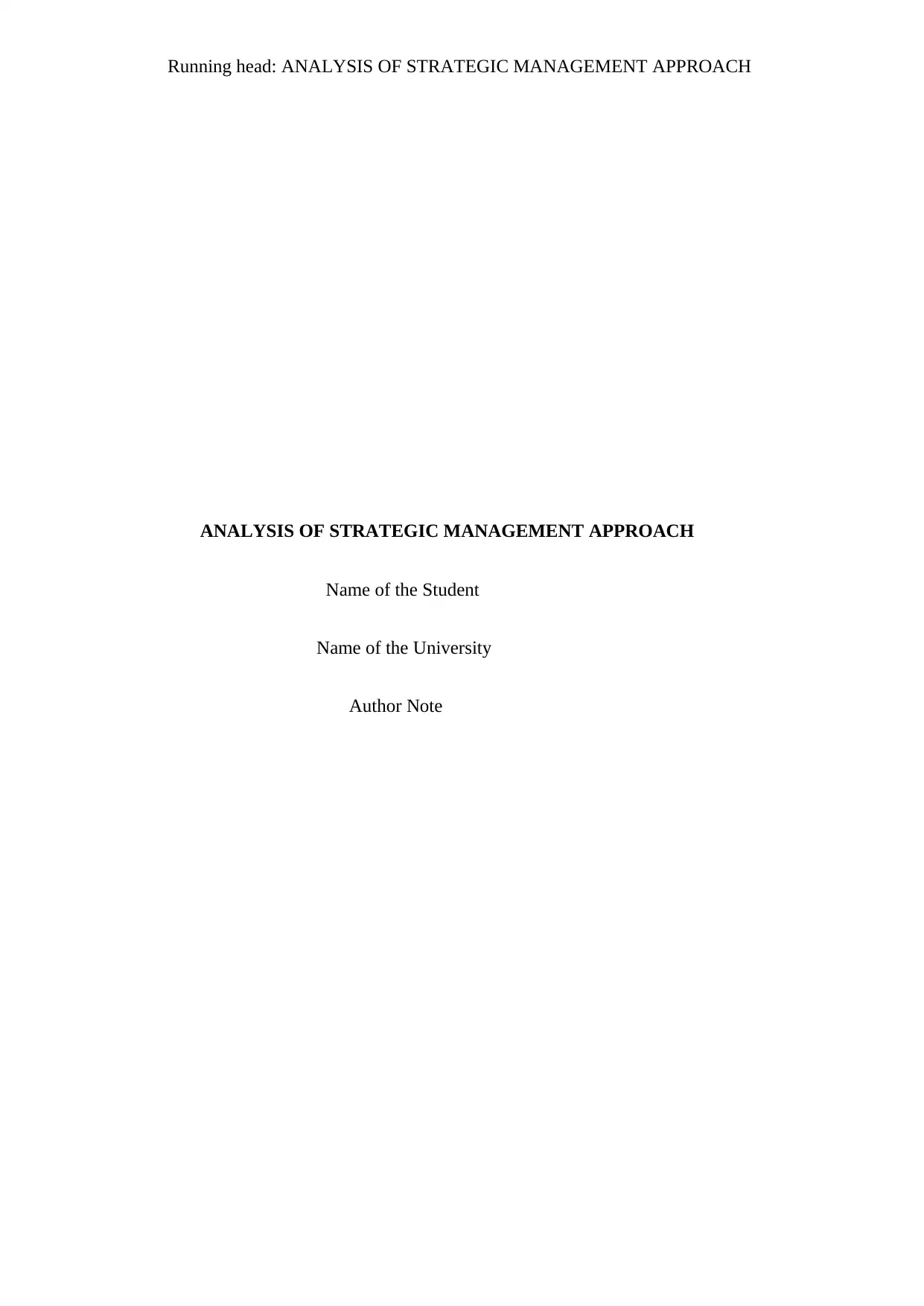
Running head: ANALYSIS OF STRATEGIC MANAGEMENT APPROACH
ANALYSIS OF STRATEGIC MANAGEMENT APPROACH
Name of the Student
Name of the University
Author Note
ANALYSIS OF STRATEGIC MANAGEMENT APPROACH
Name of the Student
Name of the University
Author Note
Paraphrase This Document
Need a fresh take? Get an instant paraphrase of this document with our AI Paraphraser
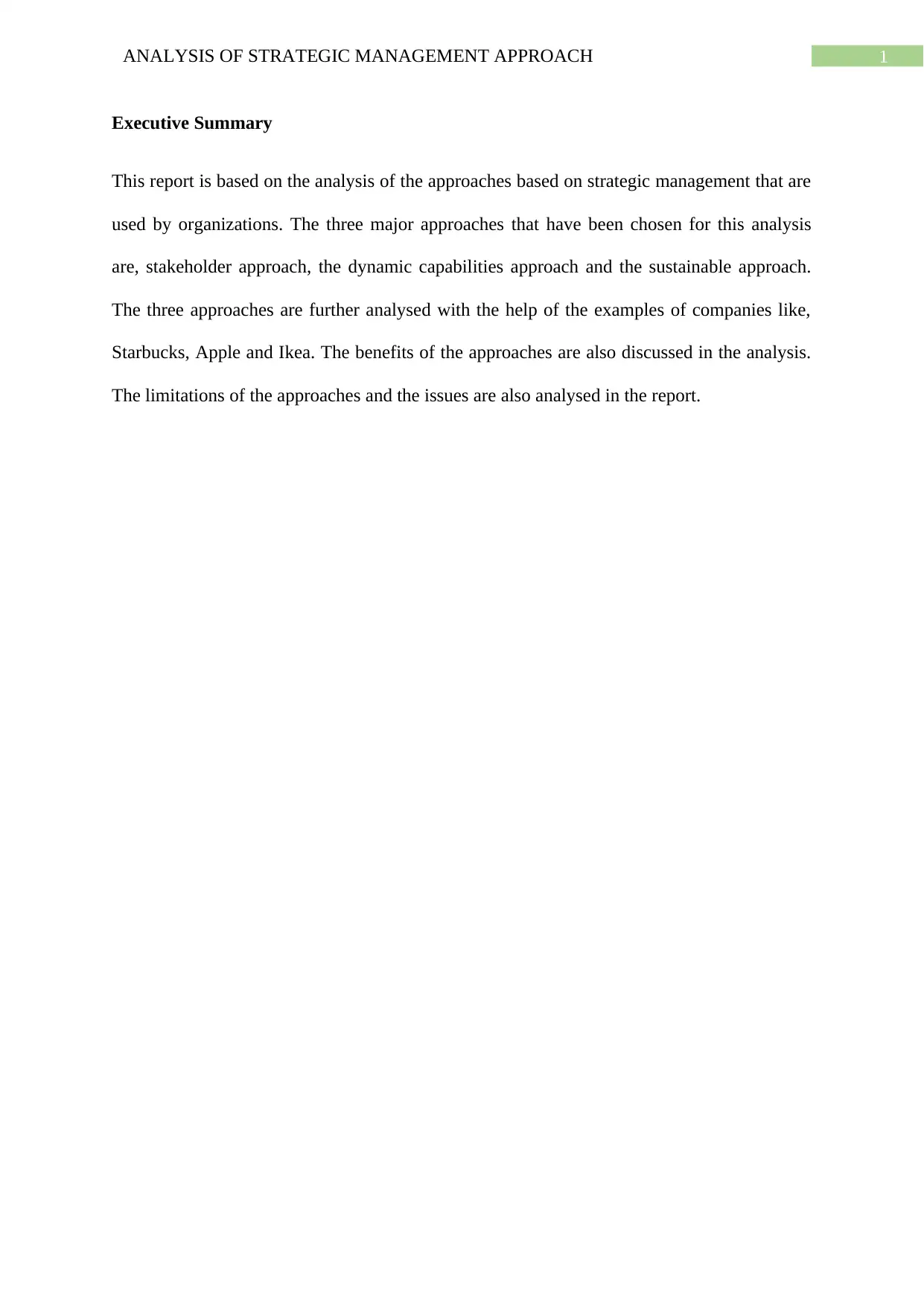
1ANALYSIS OF STRATEGIC MANAGEMENT APPROACH
Executive Summary
This report is based on the analysis of the approaches based on strategic management that are
used by organizations. The three major approaches that have been chosen for this analysis
are, stakeholder approach, the dynamic capabilities approach and the sustainable approach.
The three approaches are further analysed with the help of the examples of companies like,
Starbucks, Apple and Ikea. The benefits of the approaches are also discussed in the analysis.
The limitations of the approaches and the issues are also analysed in the report.
Executive Summary
This report is based on the analysis of the approaches based on strategic management that are
used by organizations. The three major approaches that have been chosen for this analysis
are, stakeholder approach, the dynamic capabilities approach and the sustainable approach.
The three approaches are further analysed with the help of the examples of companies like,
Starbucks, Apple and Ikea. The benefits of the approaches are also discussed in the analysis.
The limitations of the approaches and the issues are also analysed in the report.
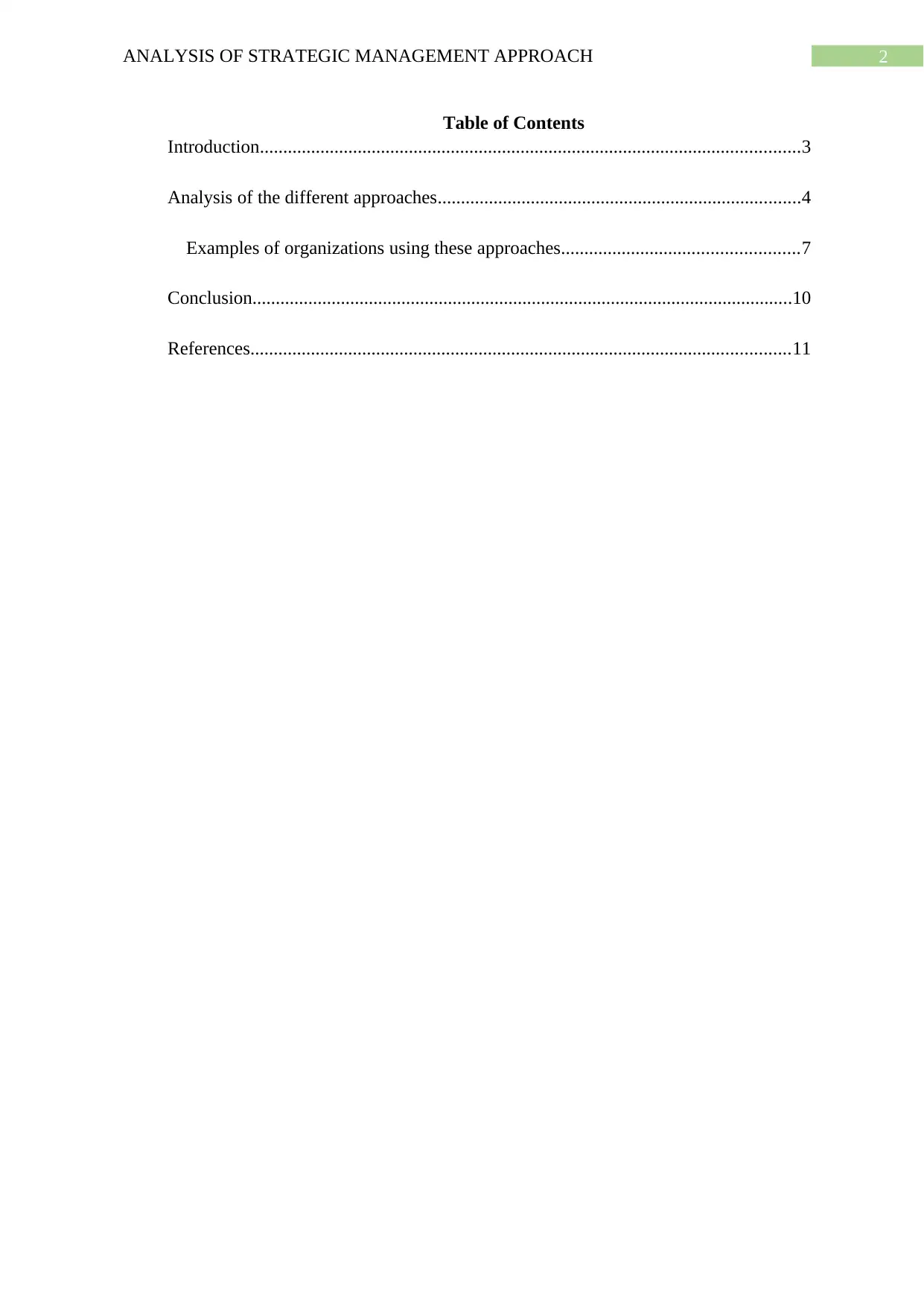
2ANALYSIS OF STRATEGIC MANAGEMENT APPROACH
Table of Contents
Introduction....................................................................................................................3
Analysis of the different approaches..............................................................................4
Examples of organizations using these approaches...................................................7
Conclusion....................................................................................................................10
References....................................................................................................................11
Table of Contents
Introduction....................................................................................................................3
Analysis of the different approaches..............................................................................4
Examples of organizations using these approaches...................................................7
Conclusion....................................................................................................................10
References....................................................................................................................11
⊘ This is a preview!⊘
Do you want full access?
Subscribe today to unlock all pages.

Trusted by 1+ million students worldwide
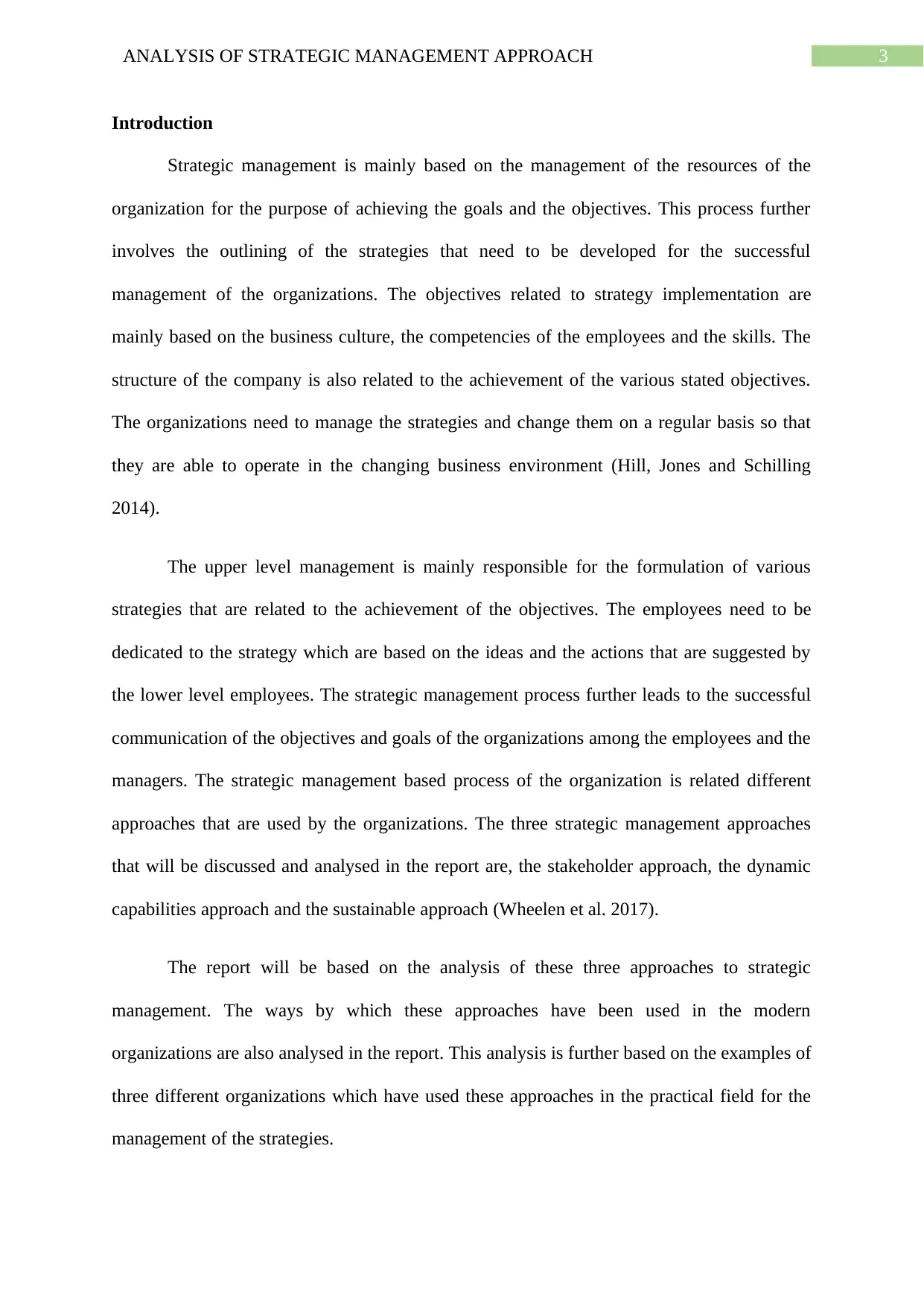
3ANALYSIS OF STRATEGIC MANAGEMENT APPROACH
Introduction
Strategic management is mainly based on the management of the resources of the
organization for the purpose of achieving the goals and the objectives. This process further
involves the outlining of the strategies that need to be developed for the successful
management of the organizations. The objectives related to strategy implementation are
mainly based on the business culture, the competencies of the employees and the skills. The
structure of the company is also related to the achievement of the various stated objectives.
The organizations need to manage the strategies and change them on a regular basis so that
they are able to operate in the changing business environment (Hill, Jones and Schilling
2014).
The upper level management is mainly responsible for the formulation of various
strategies that are related to the achievement of the objectives. The employees need to be
dedicated to the strategy which are based on the ideas and the actions that are suggested by
the lower level employees. The strategic management process further leads to the successful
communication of the objectives and goals of the organizations among the employees and the
managers. The strategic management based process of the organization is related different
approaches that are used by the organizations. The three strategic management approaches
that will be discussed and analysed in the report are, the stakeholder approach, the dynamic
capabilities approach and the sustainable approach (Wheelen et al. 2017).
The report will be based on the analysis of these three approaches to strategic
management. The ways by which these approaches have been used in the modern
organizations are also analysed in the report. This analysis is further based on the examples of
three different organizations which have used these approaches in the practical field for the
management of the strategies.
Introduction
Strategic management is mainly based on the management of the resources of the
organization for the purpose of achieving the goals and the objectives. This process further
involves the outlining of the strategies that need to be developed for the successful
management of the organizations. The objectives related to strategy implementation are
mainly based on the business culture, the competencies of the employees and the skills. The
structure of the company is also related to the achievement of the various stated objectives.
The organizations need to manage the strategies and change them on a regular basis so that
they are able to operate in the changing business environment (Hill, Jones and Schilling
2014).
The upper level management is mainly responsible for the formulation of various
strategies that are related to the achievement of the objectives. The employees need to be
dedicated to the strategy which are based on the ideas and the actions that are suggested by
the lower level employees. The strategic management process further leads to the successful
communication of the objectives and goals of the organizations among the employees and the
managers. The strategic management based process of the organization is related different
approaches that are used by the organizations. The three strategic management approaches
that will be discussed and analysed in the report are, the stakeholder approach, the dynamic
capabilities approach and the sustainable approach (Wheelen et al. 2017).
The report will be based on the analysis of these three approaches to strategic
management. The ways by which these approaches have been used in the modern
organizations are also analysed in the report. This analysis is further based on the examples of
three different organizations which have used these approaches in the practical field for the
management of the strategies.
Paraphrase This Document
Need a fresh take? Get an instant paraphrase of this document with our AI Paraphraser
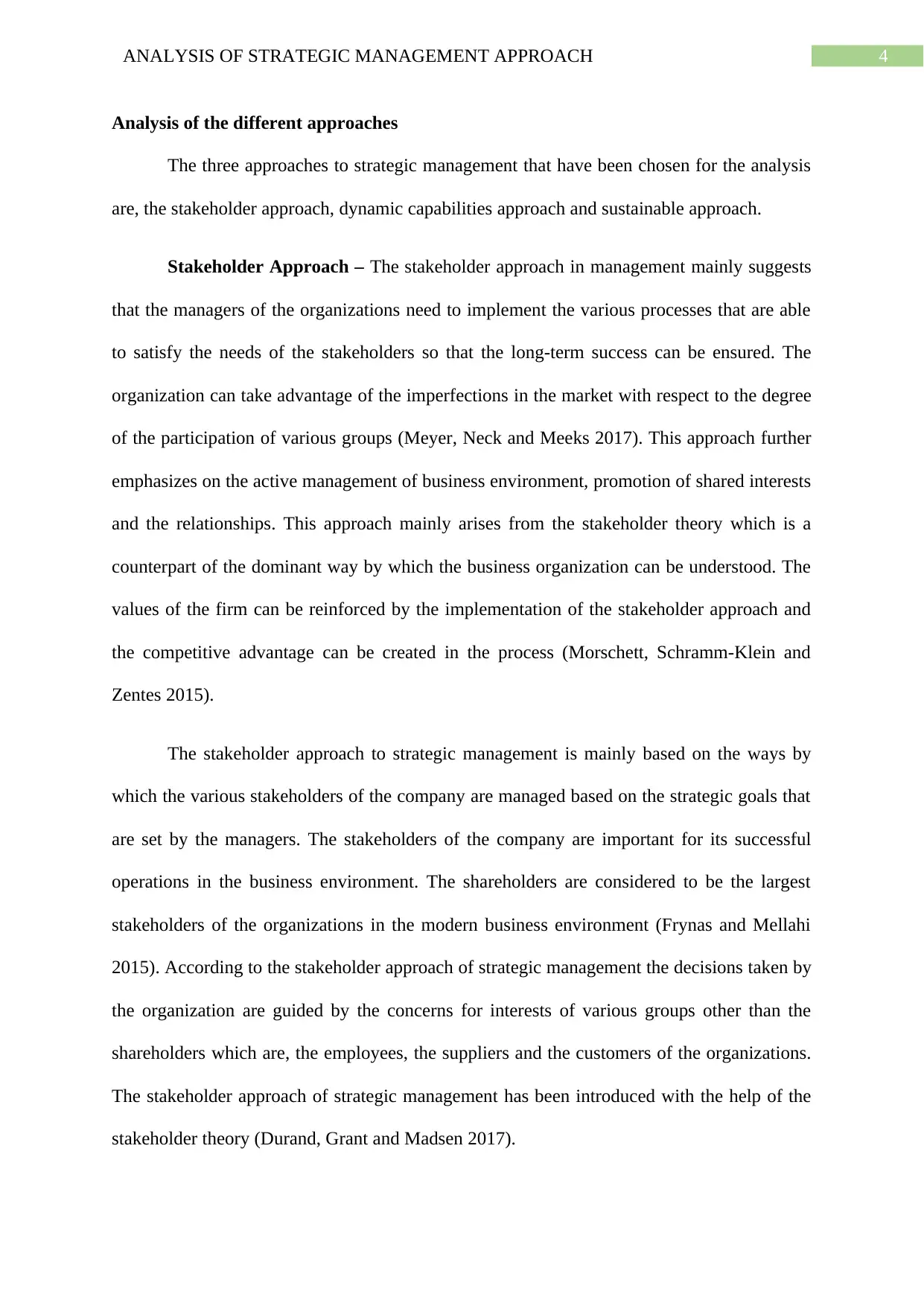
4ANALYSIS OF STRATEGIC MANAGEMENT APPROACH
Analysis of the different approaches
The three approaches to strategic management that have been chosen for the analysis
are, the stakeholder approach, dynamic capabilities approach and sustainable approach.
Stakeholder Approach – The stakeholder approach in management mainly suggests
that the managers of the organizations need to implement the various processes that are able
to satisfy the needs of the stakeholders so that the long-term success can be ensured. The
organization can take advantage of the imperfections in the market with respect to the degree
of the participation of various groups (Meyer, Neck and Meeks 2017). This approach further
emphasizes on the active management of business environment, promotion of shared interests
and the relationships. This approach mainly arises from the stakeholder theory which is a
counterpart of the dominant way by which the business organization can be understood. The
values of the firm can be reinforced by the implementation of the stakeholder approach and
the competitive advantage can be created in the process (Morschett, Schramm-Klein and
Zentes 2015).
The stakeholder approach to strategic management is mainly based on the ways by
which the various stakeholders of the company are managed based on the strategic goals that
are set by the managers. The stakeholders of the company are important for its successful
operations in the business environment. The shareholders are considered to be the largest
stakeholders of the organizations in the modern business environment (Frynas and Mellahi
2015). According to the stakeholder approach of strategic management the decisions taken by
the organization are guided by the concerns for interests of various groups other than the
shareholders which are, the employees, the suppliers and the customers of the organizations.
The stakeholder approach of strategic management has been introduced with the help of the
stakeholder theory (Durand, Grant and Madsen 2017).
Analysis of the different approaches
The three approaches to strategic management that have been chosen for the analysis
are, the stakeholder approach, dynamic capabilities approach and sustainable approach.
Stakeholder Approach – The stakeholder approach in management mainly suggests
that the managers of the organizations need to implement the various processes that are able
to satisfy the needs of the stakeholders so that the long-term success can be ensured. The
organization can take advantage of the imperfections in the market with respect to the degree
of the participation of various groups (Meyer, Neck and Meeks 2017). This approach further
emphasizes on the active management of business environment, promotion of shared interests
and the relationships. This approach mainly arises from the stakeholder theory which is a
counterpart of the dominant way by which the business organization can be understood. The
values of the firm can be reinforced by the implementation of the stakeholder approach and
the competitive advantage can be created in the process (Morschett, Schramm-Klein and
Zentes 2015).
The stakeholder approach to strategic management is mainly based on the ways by
which the various stakeholders of the company are managed based on the strategic goals that
are set by the managers. The stakeholders of the company are important for its successful
operations in the business environment. The shareholders are considered to be the largest
stakeholders of the organizations in the modern business environment (Frynas and Mellahi
2015). According to the stakeholder approach of strategic management the decisions taken by
the organization are guided by the concerns for interests of various groups other than the
shareholders which are, the employees, the suppliers and the customers of the organizations.
The stakeholder approach of strategic management has been introduced with the help of the
stakeholder theory (Durand, Grant and Madsen 2017).
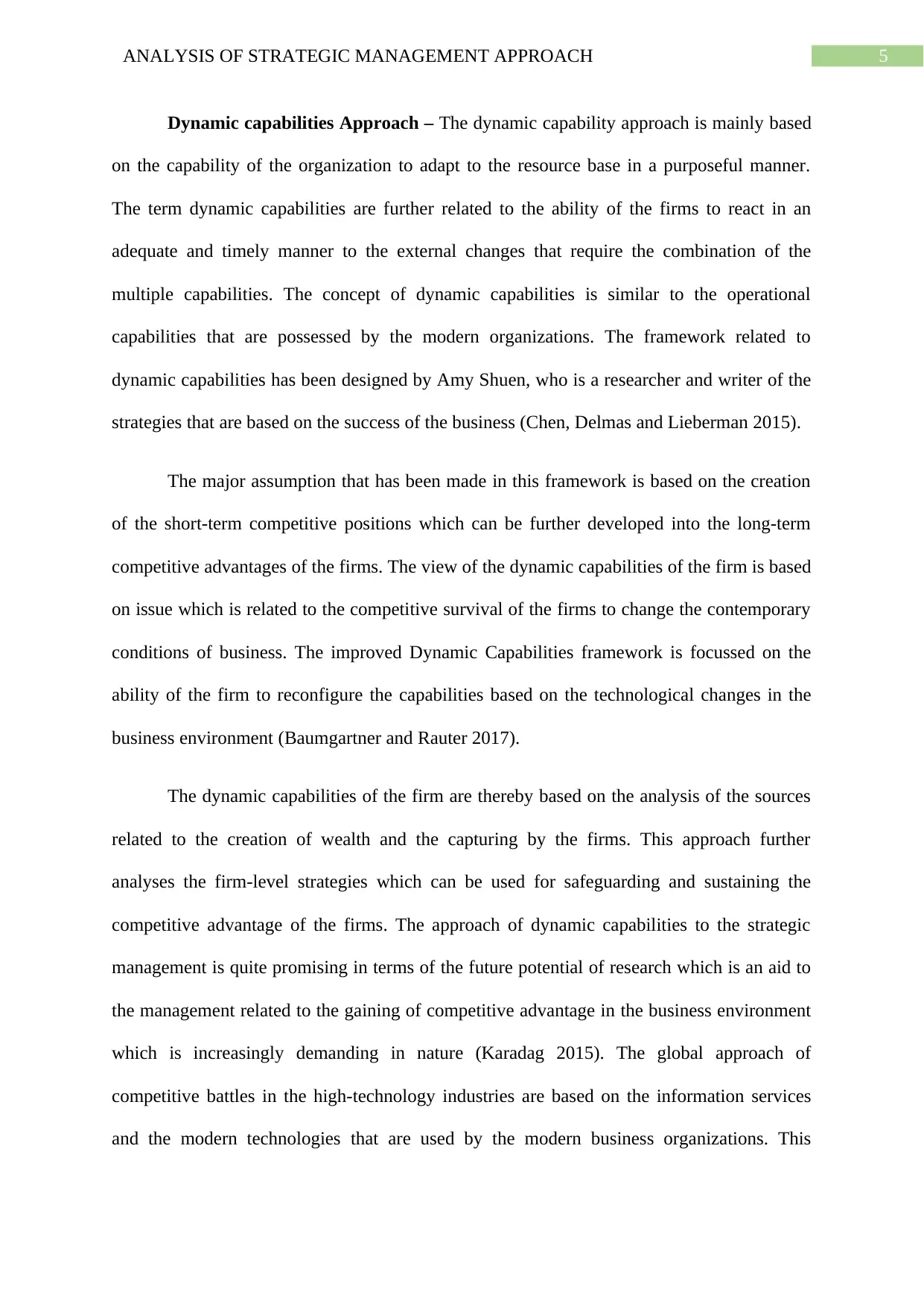
5ANALYSIS OF STRATEGIC MANAGEMENT APPROACH
Dynamic capabilities Approach – The dynamic capability approach is mainly based
on the capability of the organization to adapt to the resource base in a purposeful manner.
The term dynamic capabilities are further related to the ability of the firms to react in an
adequate and timely manner to the external changes that require the combination of the
multiple capabilities. The concept of dynamic capabilities is similar to the operational
capabilities that are possessed by the modern organizations. The framework related to
dynamic capabilities has been designed by Amy Shuen, who is a researcher and writer of the
strategies that are based on the success of the business (Chen, Delmas and Lieberman 2015).
The major assumption that has been made in this framework is based on the creation
of the short-term competitive positions which can be further developed into the long-term
competitive advantages of the firms. The view of the dynamic capabilities of the firm is based
on issue which is related to the competitive survival of the firms to change the contemporary
conditions of business. The improved Dynamic Capabilities framework is focussed on the
ability of the firm to reconfigure the capabilities based on the technological changes in the
business environment (Baumgartner and Rauter 2017).
The dynamic capabilities of the firm are thereby based on the analysis of the sources
related to the creation of wealth and the capturing by the firms. This approach further
analyses the firm-level strategies which can be used for safeguarding and sustaining the
competitive advantage of the firms. The approach of dynamic capabilities to the strategic
management is quite promising in terms of the future potential of research which is an aid to
the management related to the gaining of competitive advantage in the business environment
which is increasingly demanding in nature (Karadag 2015). The global approach of
competitive battles in the high-technology industries are based on the information services
and the modern technologies that are used by the modern business organizations. This
Dynamic capabilities Approach – The dynamic capability approach is mainly based
on the capability of the organization to adapt to the resource base in a purposeful manner.
The term dynamic capabilities are further related to the ability of the firms to react in an
adequate and timely manner to the external changes that require the combination of the
multiple capabilities. The concept of dynamic capabilities is similar to the operational
capabilities that are possessed by the modern organizations. The framework related to
dynamic capabilities has been designed by Amy Shuen, who is a researcher and writer of the
strategies that are based on the success of the business (Chen, Delmas and Lieberman 2015).
The major assumption that has been made in this framework is based on the creation
of the short-term competitive positions which can be further developed into the long-term
competitive advantages of the firms. The view of the dynamic capabilities of the firm is based
on issue which is related to the competitive survival of the firms to change the contemporary
conditions of business. The improved Dynamic Capabilities framework is focussed on the
ability of the firm to reconfigure the capabilities based on the technological changes in the
business environment (Baumgartner and Rauter 2017).
The dynamic capabilities of the firm are thereby based on the analysis of the sources
related to the creation of wealth and the capturing by the firms. This approach further
analyses the firm-level strategies which can be used for safeguarding and sustaining the
competitive advantage of the firms. The approach of dynamic capabilities to the strategic
management is quite promising in terms of the future potential of research which is an aid to
the management related to the gaining of competitive advantage in the business environment
which is increasingly demanding in nature (Karadag 2015). The global approach of
competitive battles in the high-technology industries are based on the information services
and the modern technologies that are used by the modern business organizations. This
⊘ This is a preview!⊘
Do you want full access?
Subscribe today to unlock all pages.

Trusted by 1+ million students worldwide
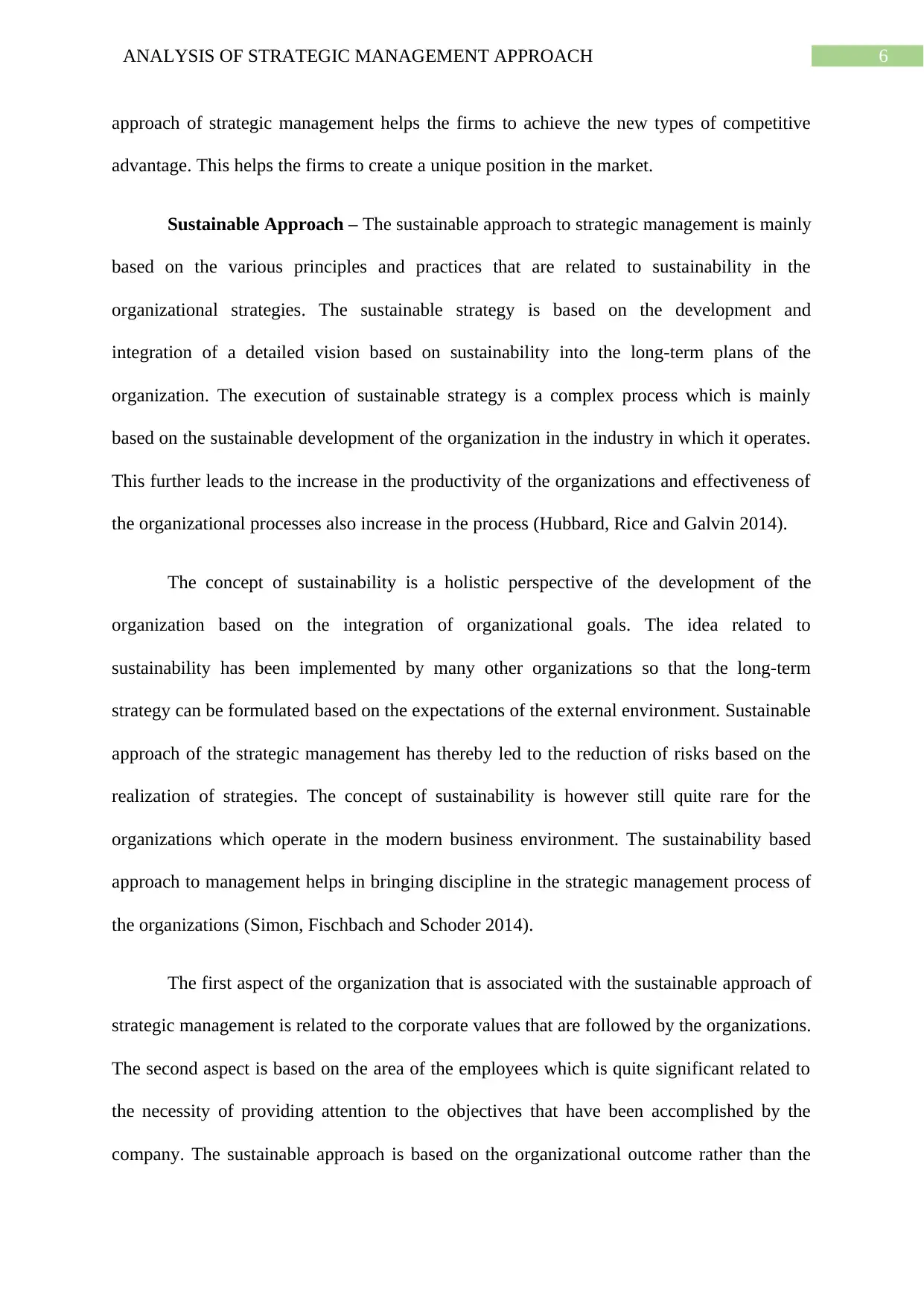
6ANALYSIS OF STRATEGIC MANAGEMENT APPROACH
approach of strategic management helps the firms to achieve the new types of competitive
advantage. This helps the firms to create a unique position in the market.
Sustainable Approach – The sustainable approach to strategic management is mainly
based on the various principles and practices that are related to sustainability in the
organizational strategies. The sustainable strategy is based on the development and
integration of a detailed vision based on sustainability into the long-term plans of the
organization. The execution of sustainable strategy is a complex process which is mainly
based on the sustainable development of the organization in the industry in which it operates.
This further leads to the increase in the productivity of the organizations and effectiveness of
the organizational processes also increase in the process (Hubbard, Rice and Galvin 2014).
The concept of sustainability is a holistic perspective of the development of the
organization based on the integration of organizational goals. The idea related to
sustainability has been implemented by many other organizations so that the long-term
strategy can be formulated based on the expectations of the external environment. Sustainable
approach of the strategic management has thereby led to the reduction of risks based on the
realization of strategies. The concept of sustainability is however still quite rare for the
organizations which operate in the modern business environment. The sustainability based
approach to management helps in bringing discipline in the strategic management process of
the organizations (Simon, Fischbach and Schoder 2014).
The first aspect of the organization that is associated with the sustainable approach of
strategic management is related to the corporate values that are followed by the organizations.
The second aspect is based on the area of the employees which is quite significant related to
the necessity of providing attention to the objectives that have been accomplished by the
company. The sustainable approach is based on the organizational outcome rather than the
approach of strategic management helps the firms to achieve the new types of competitive
advantage. This helps the firms to create a unique position in the market.
Sustainable Approach – The sustainable approach to strategic management is mainly
based on the various principles and practices that are related to sustainability in the
organizational strategies. The sustainable strategy is based on the development and
integration of a detailed vision based on sustainability into the long-term plans of the
organization. The execution of sustainable strategy is a complex process which is mainly
based on the sustainable development of the organization in the industry in which it operates.
This further leads to the increase in the productivity of the organizations and effectiveness of
the organizational processes also increase in the process (Hubbard, Rice and Galvin 2014).
The concept of sustainability is a holistic perspective of the development of the
organization based on the integration of organizational goals. The idea related to
sustainability has been implemented by many other organizations so that the long-term
strategy can be formulated based on the expectations of the external environment. Sustainable
approach of the strategic management has thereby led to the reduction of risks based on the
realization of strategies. The concept of sustainability is however still quite rare for the
organizations which operate in the modern business environment. The sustainability based
approach to management helps in bringing discipline in the strategic management process of
the organizations (Simon, Fischbach and Schoder 2014).
The first aspect of the organization that is associated with the sustainable approach of
strategic management is related to the corporate values that are followed by the organizations.
The second aspect is based on the area of the employees which is quite significant related to
the necessity of providing attention to the objectives that have been accomplished by the
company. The sustainable approach is based on the organizational outcome rather than the
Paraphrase This Document
Need a fresh take? Get an instant paraphrase of this document with our AI Paraphraser
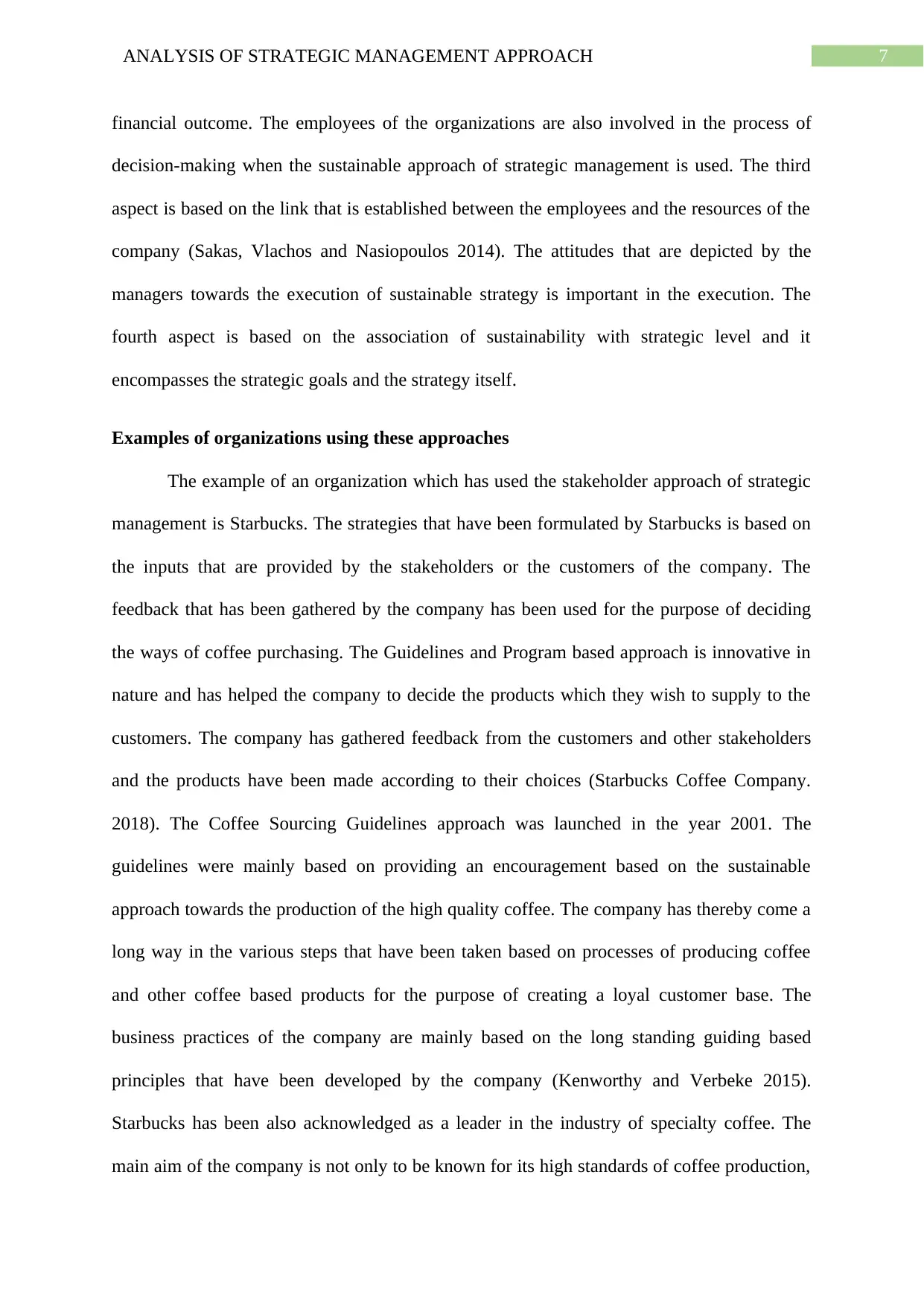
7ANALYSIS OF STRATEGIC MANAGEMENT APPROACH
financial outcome. The employees of the organizations are also involved in the process of
decision-making when the sustainable approach of strategic management is used. The third
aspect is based on the link that is established between the employees and the resources of the
company (Sakas, Vlachos and Nasiopoulos 2014). The attitudes that are depicted by the
managers towards the execution of sustainable strategy is important in the execution. The
fourth aspect is based on the association of sustainability with strategic level and it
encompasses the strategic goals and the strategy itself.
Examples of organizations using these approaches
The example of an organization which has used the stakeholder approach of strategic
management is Starbucks. The strategies that have been formulated by Starbucks is based on
the inputs that are provided by the stakeholders or the customers of the company. The
feedback that has been gathered by the company has been used for the purpose of deciding
the ways of coffee purchasing. The Guidelines and Program based approach is innovative in
nature and has helped the company to decide the products which they wish to supply to the
customers. The company has gathered feedback from the customers and other stakeholders
and the products have been made according to their choices (Starbucks Coffee Company.
2018). The Coffee Sourcing Guidelines approach was launched in the year 2001. The
guidelines were mainly based on providing an encouragement based on the sustainable
approach towards the production of the high quality coffee. The company has thereby come a
long way in the various steps that have been taken based on processes of producing coffee
and other coffee based products for the purpose of creating a loyal customer base. The
business practices of the company are mainly based on the long standing guiding based
principles that have been developed by the company (Kenworthy and Verbeke 2015).
Starbucks has been also acknowledged as a leader in the industry of specialty coffee. The
main aim of the company is not only to be known for its high standards of coffee production,
financial outcome. The employees of the organizations are also involved in the process of
decision-making when the sustainable approach of strategic management is used. The third
aspect is based on the link that is established between the employees and the resources of the
company (Sakas, Vlachos and Nasiopoulos 2014). The attitudes that are depicted by the
managers towards the execution of sustainable strategy is important in the execution. The
fourth aspect is based on the association of sustainability with strategic level and it
encompasses the strategic goals and the strategy itself.
Examples of organizations using these approaches
The example of an organization which has used the stakeholder approach of strategic
management is Starbucks. The strategies that have been formulated by Starbucks is based on
the inputs that are provided by the stakeholders or the customers of the company. The
feedback that has been gathered by the company has been used for the purpose of deciding
the ways of coffee purchasing. The Guidelines and Program based approach is innovative in
nature and has helped the company to decide the products which they wish to supply to the
customers. The company has gathered feedback from the customers and other stakeholders
and the products have been made according to their choices (Starbucks Coffee Company.
2018). The Coffee Sourcing Guidelines approach was launched in the year 2001. The
guidelines were mainly based on providing an encouragement based on the sustainable
approach towards the production of the high quality coffee. The company has thereby come a
long way in the various steps that have been taken based on processes of producing coffee
and other coffee based products for the purpose of creating a loyal customer base. The
business practices of the company are mainly based on the long standing guiding based
principles that have been developed by the company (Kenworthy and Verbeke 2015).
Starbucks has been also acknowledged as a leader in the industry of specialty coffee. The
main aim of the company is not only to be known for its high standards of coffee production,
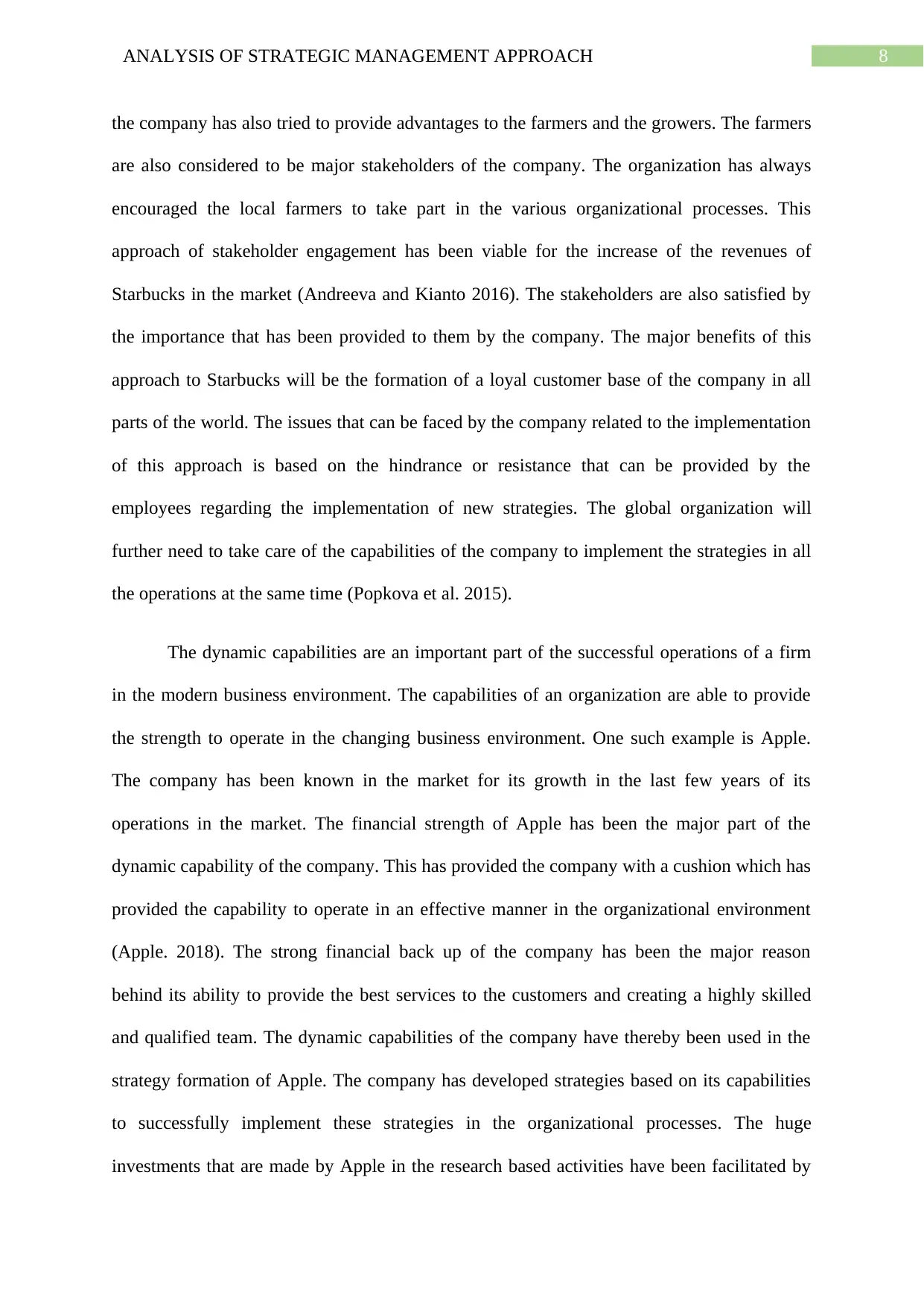
8ANALYSIS OF STRATEGIC MANAGEMENT APPROACH
the company has also tried to provide advantages to the farmers and the growers. The farmers
are also considered to be major stakeholders of the company. The organization has always
encouraged the local farmers to take part in the various organizational processes. This
approach of stakeholder engagement has been viable for the increase of the revenues of
Starbucks in the market (Andreeva and Kianto 2016). The stakeholders are also satisfied by
the importance that has been provided to them by the company. The major benefits of this
approach to Starbucks will be the formation of a loyal customer base of the company in all
parts of the world. The issues that can be faced by the company related to the implementation
of this approach is based on the hindrance or resistance that can be provided by the
employees regarding the implementation of new strategies. The global organization will
further need to take care of the capabilities of the company to implement the strategies in all
the operations at the same time (Popkova et al. 2015).
The dynamic capabilities are an important part of the successful operations of a firm
in the modern business environment. The capabilities of an organization are able to provide
the strength to operate in the changing business environment. One such example is Apple.
The company has been known in the market for its growth in the last few years of its
operations in the market. The financial strength of Apple has been the major part of the
dynamic capability of the company. This has provided the company with a cushion which has
provided the capability to operate in an effective manner in the organizational environment
(Apple. 2018). The strong financial back up of the company has been the major reason
behind its ability to provide the best services to the customers and creating a highly skilled
and qualified team. The dynamic capabilities of the company have thereby been used in the
strategy formation of Apple. The company has developed strategies based on its capabilities
to successfully implement these strategies in the organizational processes. The huge
investments that are made by Apple in the research based activities have been facilitated by
the company has also tried to provide advantages to the farmers and the growers. The farmers
are also considered to be major stakeholders of the company. The organization has always
encouraged the local farmers to take part in the various organizational processes. This
approach of stakeholder engagement has been viable for the increase of the revenues of
Starbucks in the market (Andreeva and Kianto 2016). The stakeholders are also satisfied by
the importance that has been provided to them by the company. The major benefits of this
approach to Starbucks will be the formation of a loyal customer base of the company in all
parts of the world. The issues that can be faced by the company related to the implementation
of this approach is based on the hindrance or resistance that can be provided by the
employees regarding the implementation of new strategies. The global organization will
further need to take care of the capabilities of the company to implement the strategies in all
the operations at the same time (Popkova et al. 2015).
The dynamic capabilities are an important part of the successful operations of a firm
in the modern business environment. The capabilities of an organization are able to provide
the strength to operate in the changing business environment. One such example is Apple.
The company has been known in the market for its growth in the last few years of its
operations in the market. The financial strength of Apple has been the major part of the
dynamic capability of the company. This has provided the company with a cushion which has
provided the capability to operate in an effective manner in the organizational environment
(Apple. 2018). The strong financial back up of the company has been the major reason
behind its ability to provide the best services to the customers and creating a highly skilled
and qualified team. The dynamic capabilities of the company have thereby been used in the
strategy formation of Apple. The company has developed strategies based on its capabilities
to successfully implement these strategies in the organizational processes. The huge
investments that are made by Apple in the research based activities have been facilitated by
⊘ This is a preview!⊘
Do you want full access?
Subscribe today to unlock all pages.

Trusted by 1+ million students worldwide
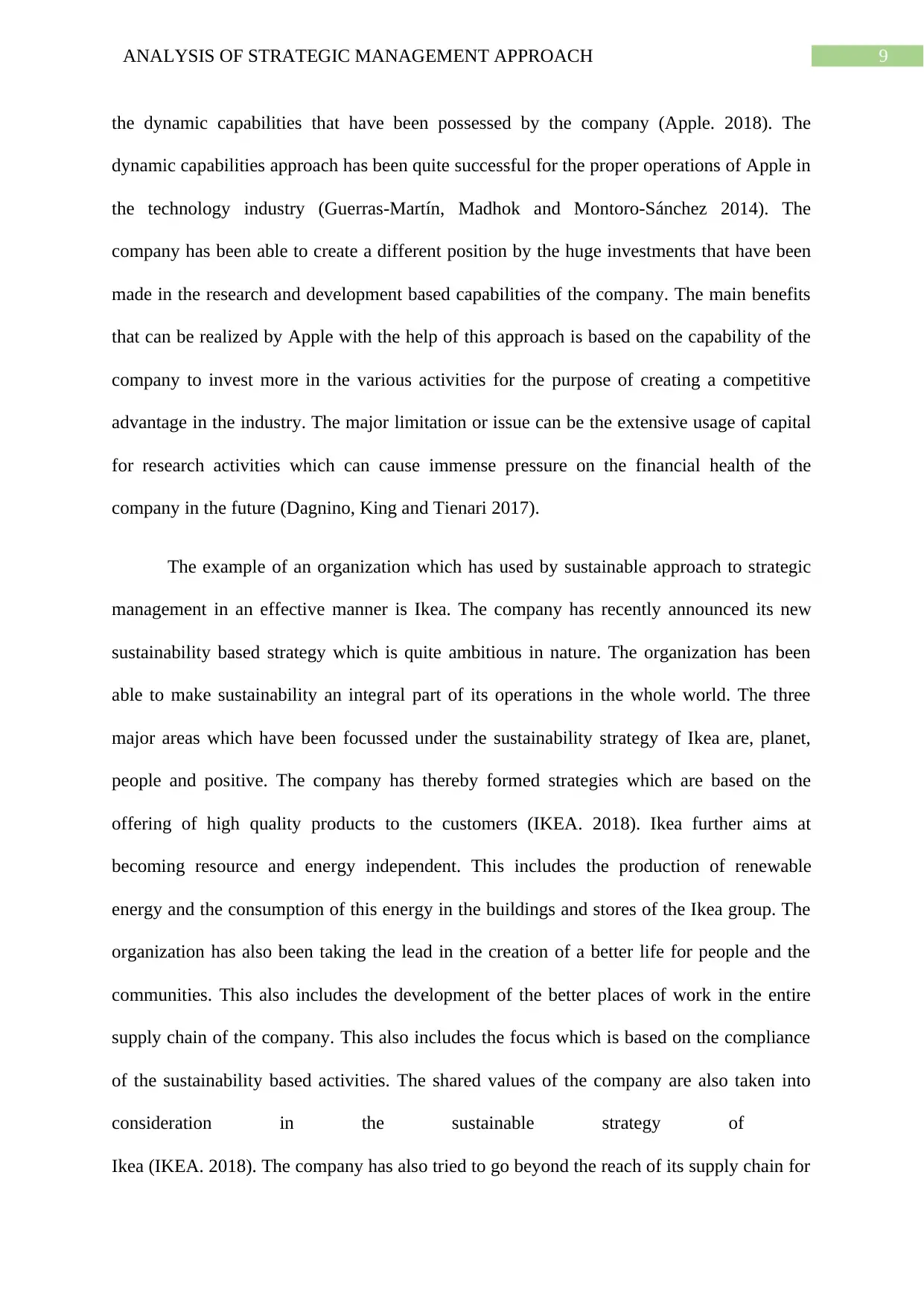
9ANALYSIS OF STRATEGIC MANAGEMENT APPROACH
the dynamic capabilities that have been possessed by the company (Apple. 2018). The
dynamic capabilities approach has been quite successful for the proper operations of Apple in
the technology industry (Guerras-Martín, Madhok and Montoro-Sánchez 2014). The
company has been able to create a different position by the huge investments that have been
made in the research and development based capabilities of the company. The main benefits
that can be realized by Apple with the help of this approach is based on the capability of the
company to invest more in the various activities for the purpose of creating a competitive
advantage in the industry. The major limitation or issue can be the extensive usage of capital
for research activities which can cause immense pressure on the financial health of the
company in the future (Dagnino, King and Tienari 2017).
The example of an organization which has used by sustainable approach to strategic
management in an effective manner is Ikea. The company has recently announced its new
sustainability based strategy which is quite ambitious in nature. The organization has been
able to make sustainability an integral part of its operations in the whole world. The three
major areas which have been focussed under the sustainability strategy of Ikea are, planet,
people and positive. The company has thereby formed strategies which are based on the
offering of high quality products to the customers (IKEA. 2018). Ikea further aims at
becoming resource and energy independent. This includes the production of renewable
energy and the consumption of this energy in the buildings and stores of the Ikea group. The
organization has also been taking the lead in the creation of a better life for people and the
communities. This also includes the development of the better places of work in the entire
supply chain of the company. This also includes the focus which is based on the compliance
of the sustainability based activities. The shared values of the company are also taken into
consideration in the sustainable strategy of
Ikea (IKEA. 2018). The company has also tried to go beyond the reach of its supply chain for
the dynamic capabilities that have been possessed by the company (Apple. 2018). The
dynamic capabilities approach has been quite successful for the proper operations of Apple in
the technology industry (Guerras-Martín, Madhok and Montoro-Sánchez 2014). The
company has been able to create a different position by the huge investments that have been
made in the research and development based capabilities of the company. The main benefits
that can be realized by Apple with the help of this approach is based on the capability of the
company to invest more in the various activities for the purpose of creating a competitive
advantage in the industry. The major limitation or issue can be the extensive usage of capital
for research activities which can cause immense pressure on the financial health of the
company in the future (Dagnino, King and Tienari 2017).
The example of an organization which has used by sustainable approach to strategic
management in an effective manner is Ikea. The company has recently announced its new
sustainability based strategy which is quite ambitious in nature. The organization has been
able to make sustainability an integral part of its operations in the whole world. The three
major areas which have been focussed under the sustainability strategy of Ikea are, planet,
people and positive. The company has thereby formed strategies which are based on the
offering of high quality products to the customers (IKEA. 2018). Ikea further aims at
becoming resource and energy independent. This includes the production of renewable
energy and the consumption of this energy in the buildings and stores of the Ikea group. The
organization has also been taking the lead in the creation of a better life for people and the
communities. This also includes the development of the better places of work in the entire
supply chain of the company. This also includes the focus which is based on the compliance
of the sustainability based activities. The shared values of the company are also taken into
consideration in the sustainable strategy of
Ikea (IKEA. 2018). The company has also tried to go beyond the reach of its supply chain for
Paraphrase This Document
Need a fresh take? Get an instant paraphrase of this document with our AI Paraphraser
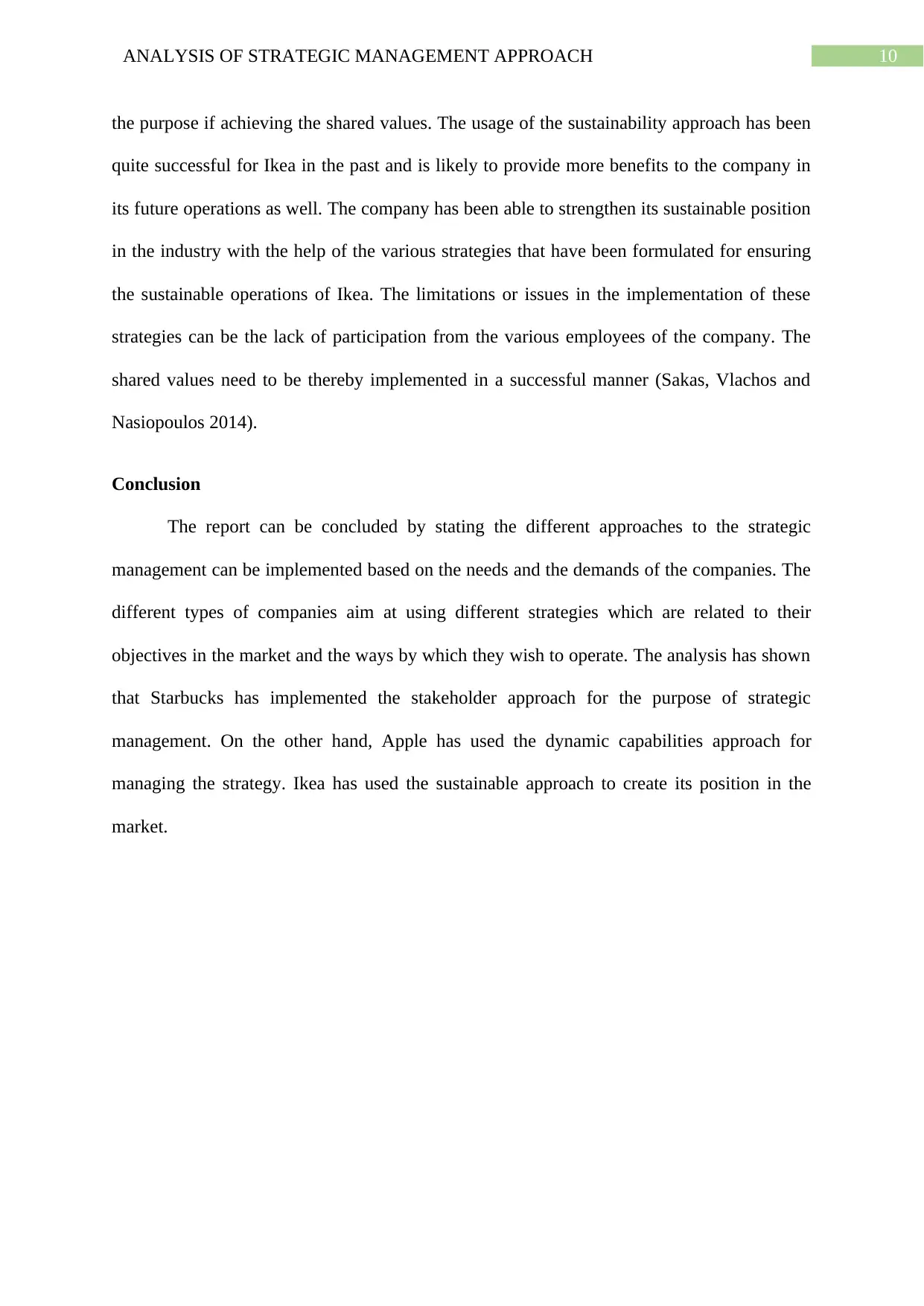
10ANALYSIS OF STRATEGIC MANAGEMENT APPROACH
the purpose if achieving the shared values. The usage of the sustainability approach has been
quite successful for Ikea in the past and is likely to provide more benefits to the company in
its future operations as well. The company has been able to strengthen its sustainable position
in the industry with the help of the various strategies that have been formulated for ensuring
the sustainable operations of Ikea. The limitations or issues in the implementation of these
strategies can be the lack of participation from the various employees of the company. The
shared values need to be thereby implemented in a successful manner (Sakas, Vlachos and
Nasiopoulos 2014).
Conclusion
The report can be concluded by stating the different approaches to the strategic
management can be implemented based on the needs and the demands of the companies. The
different types of companies aim at using different strategies which are related to their
objectives in the market and the ways by which they wish to operate. The analysis has shown
that Starbucks has implemented the stakeholder approach for the purpose of strategic
management. On the other hand, Apple has used the dynamic capabilities approach for
managing the strategy. Ikea has used the sustainable approach to create its position in the
market.
the purpose if achieving the shared values. The usage of the sustainability approach has been
quite successful for Ikea in the past and is likely to provide more benefits to the company in
its future operations as well. The company has been able to strengthen its sustainable position
in the industry with the help of the various strategies that have been formulated for ensuring
the sustainable operations of Ikea. The limitations or issues in the implementation of these
strategies can be the lack of participation from the various employees of the company. The
shared values need to be thereby implemented in a successful manner (Sakas, Vlachos and
Nasiopoulos 2014).
Conclusion
The report can be concluded by stating the different approaches to the strategic
management can be implemented based on the needs and the demands of the companies. The
different types of companies aim at using different strategies which are related to their
objectives in the market and the ways by which they wish to operate. The analysis has shown
that Starbucks has implemented the stakeholder approach for the purpose of strategic
management. On the other hand, Apple has used the dynamic capabilities approach for
managing the strategy. Ikea has used the sustainable approach to create its position in the
market.
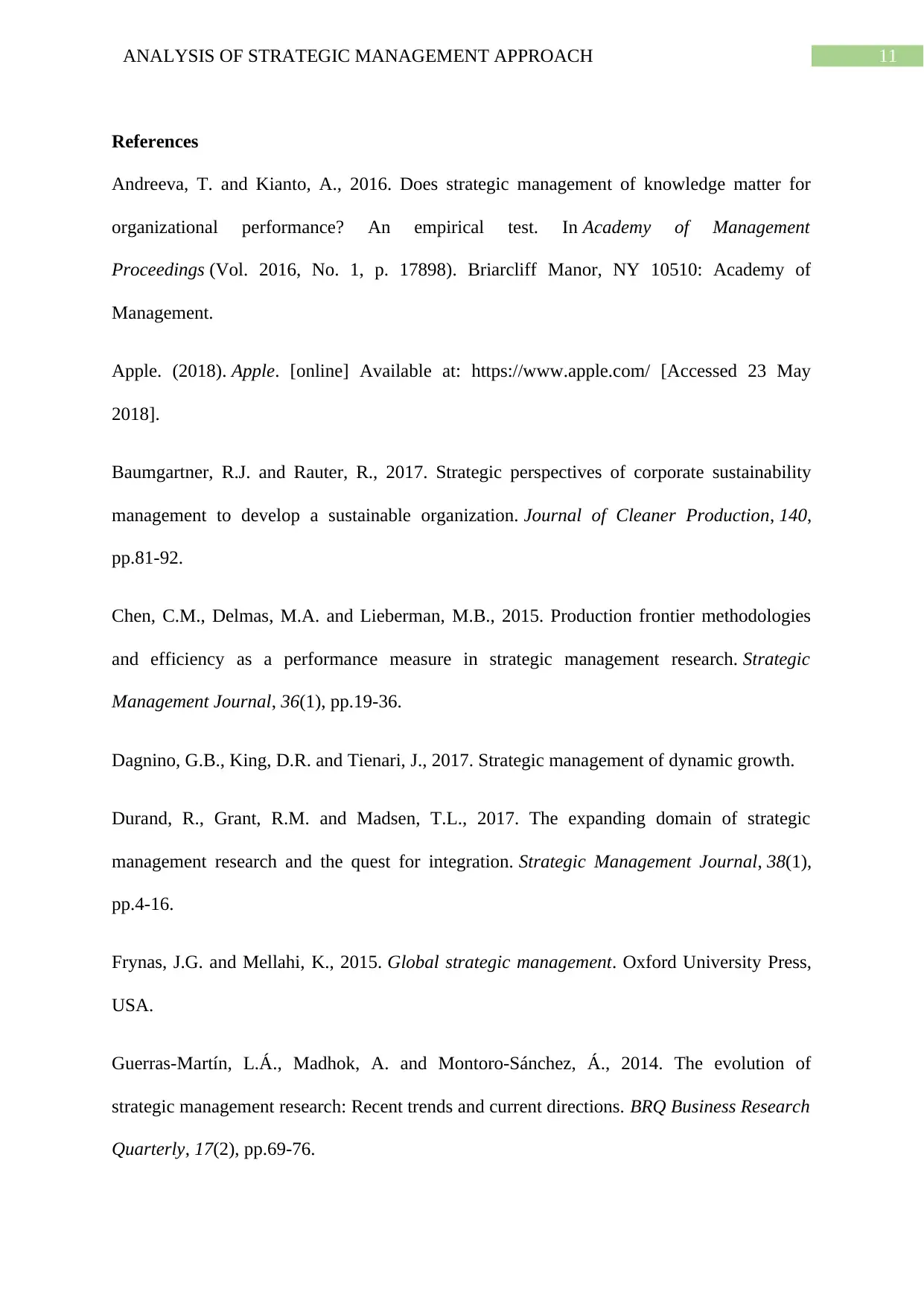
11ANALYSIS OF STRATEGIC MANAGEMENT APPROACH
References
Andreeva, T. and Kianto, A., 2016. Does strategic management of knowledge matter for
organizational performance? An empirical test. In Academy of Management
Proceedings (Vol. 2016, No. 1, p. 17898). Briarcliff Manor, NY 10510: Academy of
Management.
Apple. (2018). Apple. [online] Available at: https://www.apple.com/ [Accessed 23 May
2018].
Baumgartner, R.J. and Rauter, R., 2017. Strategic perspectives of corporate sustainability
management to develop a sustainable organization. Journal of Cleaner Production, 140,
pp.81-92.
Chen, C.M., Delmas, M.A. and Lieberman, M.B., 2015. Production frontier methodologies
and efficiency as a performance measure in strategic management research. Strategic
Management Journal, 36(1), pp.19-36.
Dagnino, G.B., King, D.R. and Tienari, J., 2017. Strategic management of dynamic growth.
Durand, R., Grant, R.M. and Madsen, T.L., 2017. The expanding domain of strategic
management research and the quest for integration. Strategic Management Journal, 38(1),
pp.4-16.
Frynas, J.G. and Mellahi, K., 2015. Global strategic management. Oxford University Press,
USA.
Guerras-Martín, L.Á., Madhok, A. and Montoro-Sánchez, Á., 2014. The evolution of
strategic management research: Recent trends and current directions. BRQ Business Research
Quarterly, 17(2), pp.69-76.
References
Andreeva, T. and Kianto, A., 2016. Does strategic management of knowledge matter for
organizational performance? An empirical test. In Academy of Management
Proceedings (Vol. 2016, No. 1, p. 17898). Briarcliff Manor, NY 10510: Academy of
Management.
Apple. (2018). Apple. [online] Available at: https://www.apple.com/ [Accessed 23 May
2018].
Baumgartner, R.J. and Rauter, R., 2017. Strategic perspectives of corporate sustainability
management to develop a sustainable organization. Journal of Cleaner Production, 140,
pp.81-92.
Chen, C.M., Delmas, M.A. and Lieberman, M.B., 2015. Production frontier methodologies
and efficiency as a performance measure in strategic management research. Strategic
Management Journal, 36(1), pp.19-36.
Dagnino, G.B., King, D.R. and Tienari, J., 2017. Strategic management of dynamic growth.
Durand, R., Grant, R.M. and Madsen, T.L., 2017. The expanding domain of strategic
management research and the quest for integration. Strategic Management Journal, 38(1),
pp.4-16.
Frynas, J.G. and Mellahi, K., 2015. Global strategic management. Oxford University Press,
USA.
Guerras-Martín, L.Á., Madhok, A. and Montoro-Sánchez, Á., 2014. The evolution of
strategic management research: Recent trends and current directions. BRQ Business Research
Quarterly, 17(2), pp.69-76.
⊘ This is a preview!⊘
Do you want full access?
Subscribe today to unlock all pages.

Trusted by 1+ million students worldwide
1 out of 14
Related Documents
Your All-in-One AI-Powered Toolkit for Academic Success.
+13062052269
info@desklib.com
Available 24*7 on WhatsApp / Email
![[object Object]](/_next/static/media/star-bottom.7253800d.svg)
Unlock your academic potential
Copyright © 2020–2025 A2Z Services. All Rights Reserved. Developed and managed by ZUCOL.




